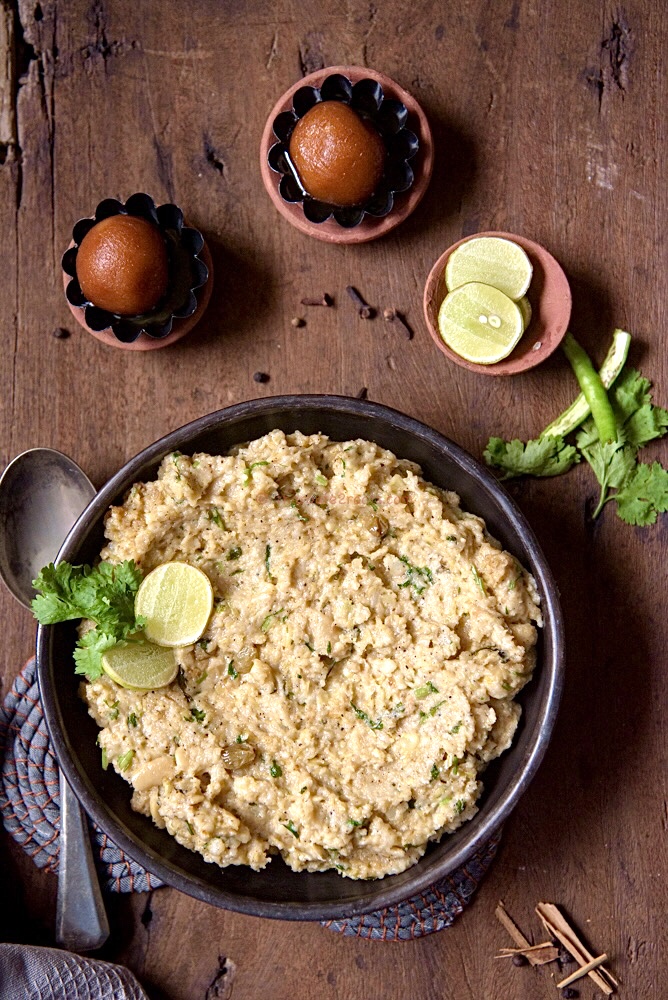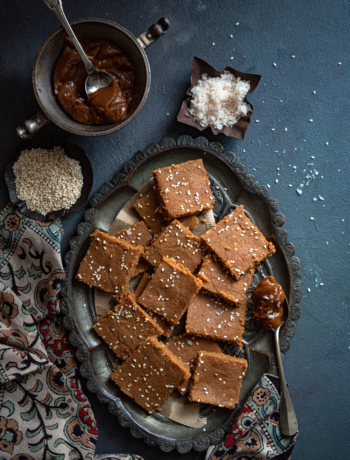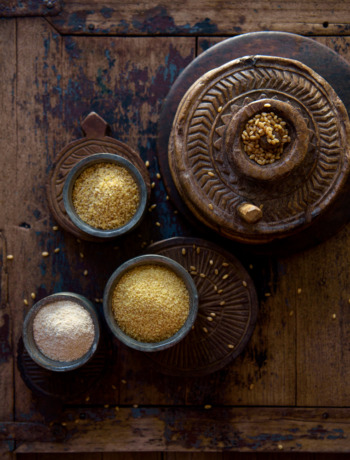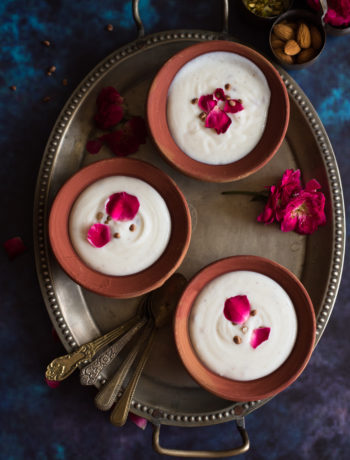Dano is a winter dish that celebrates abundance – abundance of local corn, of ghee, of friends and family, of happiness.
The cool winter air was faint with the warmth of milk and spices. The whiffs of grated desi corn roasting in oodles of ghee, carried through the wind bringing the perennial inquisitive Dakshaben to the verandah. While the rest of town was waking up from the delirium of siesta, the Sheth household was bustling with activity.
Ladies of the house were working with hurried steps. Just minutes ago, Lakhi Baa had taken out a large iron kadai and a long-handled iron tabetho (spatula) from the store room, and had asked a young Aruna to get the chulho (earthen stove) ready in the house’s vado (backyard). On her mother’s instructions, Aruna set up the chulho at a safe distance from where the household’s cattle wealth was tied. Baa poured what might seem like a barni full of ghee in the heated iron vessel, along with a fistful of green chilies and in graceful but swift motion was roasting freshly grated desi corn in ghee. It is not Diwali or any festival, nor is a prospective groom’s family coming to see Chandan, Baa’s eldest daughter. You see, the head of the household, Jetha Dada, had announced the day before the arrival of multiple guuns (large jute sacks) of desi white corn from the family farm located in the outskirts of Dahod. Panchmahal region was and still is, the only region in Gujarat where you find white corn. In light of Jetha dada’s announcement, Lakhi Baa had gathered troops post lunch, and was busy with the preparation of what would follow for dinner that evening – Desi Makai no Dano ane tajja(fresh) Gulab Jamun. The timeline is sometime in the 1950’s, and the scenes are described elaborately from my dad’s and foi’s(paternal aunts) stories and memories of their maternal grandparents.
Desi Makai no Dano is an iconic dish made by the people of Dahod that celebrates the abundance of desi corn grown in the Panchmahal region. Dano derives its name from the Gujarati word for corn kernels – makai na dana; a dish made from dana became known as dano ( daa-no) – desi makai no dano. Anatomically, desi corn is white/ivory colored while American corn is yellow. Nutritionally, desi corn is far superior with lower sugar content and high proportion of vitamins and minerals compared to its American counterpart. Unlike American corn, desi corn kernels are harder to chew and grate. In addition to strength, grating desi corn requires labor of love to feed three to four generations of family members residing under one roof. Traditionally, Desi Makai no Dano is made exclusively from grated desi white corn roasted in ample ghee, reduced in milk, and elevated with heat and flavors from green chilies, black pepper powder and garam masala. Ghee in Dano works as a cooking medium to cook the grated corn and doubles as a seasoning agent towards the end to add untold richness to the final dish. The reduction of corn in milk enables the corn to continue to cook, while changing the flavor from nutty to creamy and adding depth in taste. While ghee and milk are essential to achieve well-cooked creamy corn, the beauty of Dano comes from the dramatic clash of dairy (milk, ghee) and spices – a clever application of negative flavor pairing principle. Food pairing theory suggests that the more flavor compounds two foods have in common, the better they will taste together. However, Indian cuisine is an exception to this rule and it is perhaps its rebellious nature that creates strong and delicious flavors. A 2015 paper on Analysis of Food Pairing in Regional Cuisines of India by Jain, A. et al, indicates that each regional cuisine follows a negative food pairing pattern of which, spice and dairy emerged as the most significant ingredient classes responsible for the biased pattern of food pairing in Indian cuisines. Examples of this theory are seen in Kadhi, Batata vada & fruit salad combo, malai kofta, raitas, Manglorean korri gassi (chicken cooked in coconut milk, tamarind and other spices), to list a few. One can infer that the negative food pairing principle has a lot to do with why spicy Dano is paired with milky gulab jamuns and not jalebi, and why reduction of corn in milk combined with green chilies and other hot spices blends beautifully in this dish to create a smooth symphony of opposing flavors.
Milk and ghee-rich Dano at my great grandma’s house was cooked, eaten and shared with equal magnanimity. If a community helper came at the door, they too would be given padiya (bowlful) of Dano. Fresh white corn from the farm was shared with friends and neighbors – the grandkids would be assigned the job of delivering fresh desi corn in the falia (neighborhood).
As decades passed, there have been addendums to the Dano recipe; use of 50-50 oil and ghee (sometimes even greater proportions of oil to ghee), a mix of american and desi corn to keep the grating easier, addition of cumin-coriander powder, and other abominations. Let’s pray for forgiveness of those ignorant souls, for Lord, they know not what they do 😂.
While one of a kind, Dano has a cousin in makai no chevdo – a dish made in the Charotar region of Gujarat. The key difference between the two lies in the use of cooking medium – Dano uses ghee and milk while makai no chevdo relies solely on being cooked in oil. A peculiarity of Dano is that it is not served hot. It is allowed to cool at room temperature and eaten with warm gulab jamuns. It would occasionally be accompanied by ringan bateta nu shaak (spicy eggplant potato sabji) or jamak galka nu shaak (sabji from a kind of gourd) and be padi rotli, but it would always be served alongside a pangat of loved ones. The pairing of Dano with regular Gujarati rotli and shaak permits an economical balance to the dish loaded with rich ingredients, especially when feeding a group of 20-25, which was quite common in the olden times. Dano is made a few times during winter and always with friends and family around. I remember gathering with my dad’s friends and their families every Diwali at Chamunda mataji temple atop a hill in Dahod. Gulab jamuns were bought from the local confectioners, but Dano would be made from scratch with desi corn. The men of the group would do the entire heavy lifting – setting up, grating corn, roasting, while the ladies would tightly clad themselves in shawls and chatter about the latest tantalizing gossip. Desi Makai no Dano and gulab jamuns would be served in padiya (bowls made of khakhra leaves) and we’d leave for home with our hearts and stomachs full.
Dano seems to have its origin in makai na ponkhya; a dish made by Bhils – native tribes of Panchmahal region. Bhils of the area self-sustain and grow their own white corn for consumption. With the abundance of white corn all over the region, plenty of dishes are made white corn as the central character – from rotlas to sabzi that is eaten with it. One such is makai na ponkhya. For ponkhya, sun dried corn kernels are ground coarsely (bharadvu) in an in-home ghanti (stone mill). The coarse kernels are tempered using dodi nu tel (oil from Mahuda tree) and dried red chilies, cooked in water, and eaten with hand-sculpted makai na rotla.
Sheetal’s recent trip to my dad’s hometown, Dahod – the land of white corn, evoked memories of Dano that I grew up eating. Dano is such a lesser known dish that I am compelled to share my heirloom recipe, so you can experience the divinity that it is. The following recipe of Dano has been passed down from my great grandmother, my dad’s maternal grandma – Lakhi baa. It is laden with love and ghee:

Desi Makai no Dano
Ingredients
- 1 cup ghee
- 1 tablespoon finely chopped green chilies (more or less as per desired level of heat)
- 1/2 teaspoon asafoetida/hing (a little extra than what usual recipes call for)
- 2 cups grated desi while makai
- 2 cups milk
- 1/2 teaspoon turmeric powder (optional) (Dano would be offered to Thakorji, so Lakhi Baa did not add turmeric)
- 1/2 - 1 tbsp garam masala / kalo or black masala
- 1 teaspoon black pepper powder
- salt to taste
- sugar to taste ( desi makai tends to be little sweet so add the sugar after tasting)
- lemon juice (to balance the sweetness)
Instructions
In hot kadai, add 3/4 cup ghee, green chilies and hing.
Add grated corn and cook it really well until ghee releases from the sides. Cook the corn on low flame, do not rush this step. It will take time and proper roasting will ensure better texture of the Dano.
Once that happens, add the milk, salt and cook while constantly stirring until the milk reduces to 80%.
At this point, add garam masala, and a little more ghee. Once the ghee releases from the milk reduced mixture, dano is cooked. For the final step, add black pepper powder, little sugar, add the final bit of ghee and mix well. Turn off heat.
Round out the flavors by garnishing with lemon juice.
The final product should be spicy, but rich in taste because of ghee and milk, with just a hint of added sweetness that is more balancing than overpowering.
Serve Dano in a bowl alongside warm gulab jamuns, add a final drizzle of ghee, dig deep to it’s soft core, lifting all the ghee settled at the bottom, and feel the overlapping, well-blended creamy, spicy flavors as they glide over your tongue, linger, and make way to your soul.
Shivani Sheth is a Data Scientist who authors the food blog themediumspicy. She loves reimagining, redesigning traditional food in a modern context and pens nostalgic food stories. You can follow her narratives here.





1 Comment
Megha
September 5, 2024 at 11:52 amBeautifully explained. I have had the privilege of eating dano in Baria made by a relative in her home.. just got desi corn from matunga market and googled for the recipe with panchmahal in the search words and forms your post. I think in our house we don’t add garam masala, rest of the things are absolutely same.. can’t wait to make it as per your instructions.. Thank you ❤️